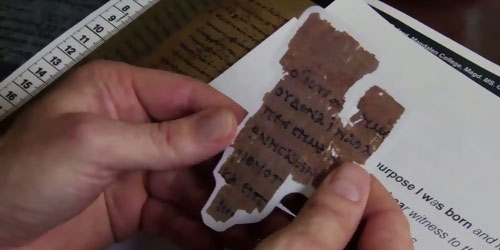To avoid the risk of employing the divine name irreverently, the sages ruled that one should not utter it at all.
Hebrew Nuggets, Lesson 5: Abba (Part 1)

Abba is an Aramaic word meaning “the father.” This word was borrowed by Hebrew speakers and used in the sense of “Daddy.” In lesson five, the word Abba is used to teach another Hebrew letter.
The Syndicated Donkey

Randall Buth may have discovered a significant idiom in the Greek text of Luke. This idiom could help us in determining the original language of Jesus’ biography. In Luke 19:33, did the donkey that Jesus rode into Jerusalem on Palm Sunday have more that one owner as the Greek text states?
Jesus and the Oral Torah: Blessing

There is evidence that Jesus adhered to the rulings of the Oral Torah in his use of various blessings.
Hebrew Nuggets, Lesson 4: Jesus’ Hebrew Name (Part 4)

Jesus’ Hebrew name is composed of three syllables: ye·SHU·a‘. In this lesson we will learn the two sounds of the final syllable of Jesus’ name. The fifth sound in Jesus’ Hebrew name יֵשׁוּע is “a” as in the word “father.” Like the tseRE and the shuRUK, this sound is a vowel. The symbol used to represent this sound is called paTAḤ. It is indicated by a horizontal line below the letter with which it is sounded. Here it appears below the last letter of ישועַ (yeSHUa‘).
Jesus’ Use of “Amen”: Introduction or Response?

It is not surprising to find the word “amen” attributed to Jesus in the Gospels. What is unusual is to find “amen” used as the beginning of a statement rather than as a response.
Discovering the Hebrew Undertext of the Synoptic Gospels

One may contend that there existed a basic text of Jesus’ life story written in Hebrew. One arrives at this assumption not merely on the basis of the church fathers’ writings, but because the Greek texts of the synoptic gospels show so much evidence of being “translation Greek,” that is, Greek that contains Hebrew idioms and sentence structures.
Jesus and the Oral Torah: Written and Oral Torah

The Torah was given by God as a guideline for a whole way of life.
Hebrew Nuggets, Lesson 3: Jesus’ Hebrew Name (Part 3)

In this lesson we will learn the two sounds of the second syllable of Jesus’ Hebrew name. The first sound of the second syllable of יֵשׁוּעַ (ye·SHU·a‘) is the “sh” sound. This is represented by ש (shin), the twenty-first letter of the Hebrew alphabet. Written with three points or teeth, it got its name from the Hebrew word for “tooth” because of the pictograph upon which it was based.
“Prophet” as a Messianic Title

There can be little doubt that Jesus viewed himself as a prophet, and that many of his contemporaries concurred.
Jesus in Judea

Robert Lindsey believed that there is sufficient evidence in Matthew, Mark and Luke to support the existence of Jesus’ Judean ministry.
Semitic Background to the Nain Story

The short account of the resurrection of the widow’s son in Nain has a very Semitic feeling. If the Nain story was written originally in Greek, it is a very semitically flavored Greek. Several linguistic features of this story suggest that it may have been written originally in Hebrew.
Hebrew Nuggets, Lesson 2: Jesus’ Hebrew Name (Part 2)

Many of Jesus’ words were spoken against a profoundly Hebraic background. We believe that a knowledge of Hebrew is central to understanding much of what Jesus said, and what was written about him in the Gospels. This is the second of a series of articles about the Hebrew language. Hopefully, these “nuggets” will encourage you to explore the riches Hebrew study can offer to those who want to understand the Bible more fully. The second sound in Jesus’ Hebrew name, יֵשׁוּעַ (ye·SHU·a‘), is a vowel. Hebrew vowels are represented by signs that are placed under, or sometimes, to the left of consonants (letters). A vowel is pronounced after the consonant that carries its sign.
Has a Gospel in Hebrew Been Found?

From time to time, one hears reports of the discovery of a portion of the New Testament written in Hebrew or Aramaic. To date, such reports have proven false. There is not a single extant Hebrew-language or Aramaic-language manuscript from the early Christian era of any of the New Testament books.
Hebrew Nuggets, Lesson 1: Jesus’ Hebrew Name (Part 1)

In my view, Hebrew is the key to understanding the Jewish background to Jesus’ words. Jerusalem Perspective, therefore, features a serialized Hebrew course for beginners. Each issue will include a bite-sized Hebrew lesson.
Was Jesus a Confirmed Bachelor?

Jesus still relatively young when he was crucified. His death may have come before he had a chance to marry.
Is Desiring Justice for Palestinians Anti-Semitic?

One cannot be pro-Palestinian and anti-Israel; neither can one be pro-Israel and anti-Palestinian.


